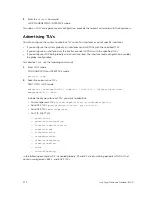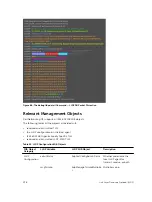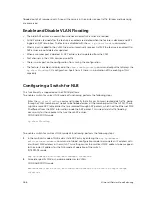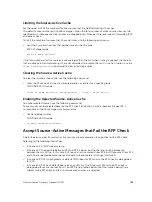
26
Microsoft Network Load Balancing
This functionality is supported on Dell Networking OS.
Network Load Balancing (NLB) is a clustering functionality that is implemented by Microsoft on Windows
2000 Server and Windows Server 2003 operating systems. NLB uses a distributed methodology or
pattern to equally split and balance the network traffic load across a set of servers that are part of the
cluster or group. NLB combines the servers into a single multicast group and attempts to use the
standard multicast IP or unicast IP addresses, and MAC addresses for the transmission of network traffic.
At the same time, it also uses a single virtual IP address for all clients as the destination IP address, which
enables servers to join the same multicast group in a way that is transparent to the clients (the clients do
not notice the addition of new servers to the group). The clients use a cluster IP address to connect to
the server. The NLB functionality enables flooding of traffic over the VLAN ports (for unicast mode) or a
subset of ports in a VLAN (for multicast mode) to avoid overloading and effective performance of the
servers for optimal processing of data packets.
NLB functions in two modes, namely unicast mode and multicast mode. The cluster IP address and the
associated cluster MAC address are configured in the NLB application running on the Windows Server. In
the unicast mode, when the server IP address is attempted to be resolved to the MAC address using the
ARP application, the switch determines whether the ARP reply, obtained from the server, is of an NLB
type. The switch then maps the IP address (cluster IP) with the MAC address (cluster MAC address). In
multicast mode, the cluster IP address is mapped to a cluster multicast MAC address that is configured
using a static ARP CLI configuration command. After the NLB entry is learned, the traffic is forwarded to
all the servers in the VLAN corresponding to the cluster virtual IP address.
NLB Unicast Mode Scenario
Consider a sample topology in which four servers, namely S1 through S4, are configured as a cluster or a
farm. This set of servers is connected to a Layer 3 switch, which in turn is connected to the end-clients.
The servers contain a single IP address (IP-cluster address of 172.16.2.20) and a single unicast MAC
address (MAC-Cluster address of 00-bf-ac-10-00-01) for load-balancing. Because multiple ports of a
switch cannot learn a single MAC address, the servers are assigned with MAC addresseses of MAC-s1 to
MAC-s4) respectively on S1 through S4 in addition to the MAC cluster address. All the servers of the
cluster belong to the VLAN named VLAN1.
In unicast NLB mode, the following sequence of events occurs:
• The switch sends an ARP request to resolve the IP address to the cluster MAC address.
• The ARP servers send an ARP response with the MAC cluster address in the ARP header and a MAC
address of MAC-s1/s2/s3/s4 (for servers S1 through S4) in the Ethernet header.
• The switch associates the IP address with the MAC cluster address with the last ARP response it
obtains. Assume that in this case, the last ARP reply is obtained from MAC-s4.(assuming that the ARP
response with MAC-s4 is received as the last one). The interface associated with server, S4, is added
to the ARP table.
484
Microsoft Network Load Balancing
Summary of Contents for Z9000
Page 1: ...Dell Configuration Guide for the Z9000 System 9 7 0 0 ...
Page 80: ...grub reboot 80 Management ...
Page 128: ... 0 Te 1 1 Te 1 2 rx Flow N A N A 128 Access Control Lists ACLs ...
Page 491: ...Figure 70 Configuring OSPF and BGP for MSDP Multicast Source Discovery Protocol MSDP 491 ...
Page 496: ...Figure 73 MSDP Default Peer Scenario 1 496 Multicast Source Discovery Protocol MSDP ...
Page 497: ...Figure 74 MSDP Default Peer Scenario 2 Multicast Source Discovery Protocol MSDP 497 ...
Page 498: ...Figure 75 MSDP Default Peer Scenario 3 498 Multicast Source Discovery Protocol MSDP ...
Page 760: ...Figure 100 Single and Double Tag TPID Match 760 Service Provider Bridging ...
Page 761: ...Figure 101 Single and Double Tag First byte TPID Match Service Provider Bridging 761 ...















































